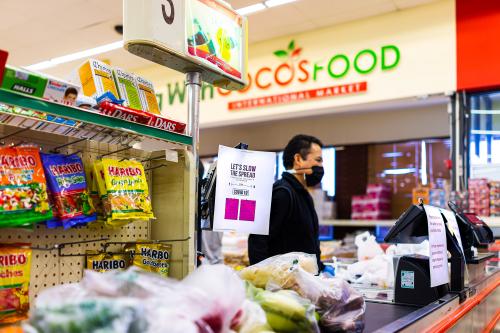A funny thing happened on the Senate floor in the wee hours of February 5. As senators worked through a series of amendments in the “vote-a-rama” to advance President Joe Biden’s $1.9 trillion rescue package, Sen. Joni Ernst (R-Iowa) moved to strike any provision raising the federal minimum wage to $15 per hour this year. And none other than progressive lion Sen. Bernie Sanders (I-Vt.) rose to agree.
Pundits theorized that Ernst sought to trap Democrats, especially those from battleground states, into voting in favor of a minimum wage increase while the nation is still in the throes of the pandemic. But that’s not congressional Democrats’ position: Sanders and his allies support raising the minimum wage gradually, over a four-year period. In the end, no Democrats opposed Ernst’s amendment.
The belief that Democrats want to dramatically and immediately raise the federal minimum wage—a belief the National Restaurant Association has eagerly fueled—isn’t the only myth floating around about the proposal. Critics also declare that increase is only popular with progressives and that it will be a “job killer” for restaurants and other hard-hit small businesses, especially in lower-wage regions.
One of us runs a restaurant in a very high-cost market, so we understand concerns that raising the minimum wage might limit hiring or even drive more restaurants and other small companies out of business. But we need to get some facts straight.
First of all, raising the minimum wage isn’t just a progressive position. There is now robust bipartisan support among voters for a significant increase in the federal minimum wage, which has not budged in a dozen years. In November, Florida voters approved an increase to the state minimum wage by a margin 11 points wider than Donald Trump’s victory there. (Florida became the first state in the South, and eighth in the nation, to approve a gradual hike to $15.) Meanwhile, a Quinnipiac poll conducted in late January found that 61% of Americans favor the increase to $15 at the federal level.
A new Brookings analysis shows that pre-COVID-19, about half of workers earning less than $15 an hour were essential workers—a share that is likely higher now because of the pandemic’s disproportionate effects on low-wage occupations. Voters across the spectrum have come to agree that it is simply not possible for workers—essential or otherwise—to survive on the federal minimum of $7.25 an hour or the state wage floors close to that.
But it’s even less possible to survive on restaurant and other service work that relies on tips and is still paid a subminimum rate: $5 an hour or less in 38 states. Heavy reliance on tips rather than wages meant that for many workers laid off during the pandemic, total earnings were too low to even qualify them for unemployment insurance, as labor researchers at the University of California at Berkeley found last year.
Over 110,000 restaurants have shuttered during the pandemic, and Black restaurateurs and other owners of color—along with their workers—have been hit especially hard. But just as voters have realized that the minimum wage in America is a poverty sentence, leaders in the restaurant business—the nation’s largest source of private sector jobs—are waking up to the fact that the industry will not survive unless it changes dramatically. On this point in particular, the restaurant industry is a microcosm of the American economy.
Many restaurants must raise wages to attract and retain workers, who face new safety risks as well as the loss of income from a big drop in tips. Evidence shows that raising wages can cut expensive employee turnover in half and trigger a shift to new business models, as Seattle and other local markets show. This adaptation—which is a crucial part of the future of retail more generally—is just one thing that pessimistic economic projections of the effects of a federal minimum wage hike (like that by the Congressional Budget Office) ignore or downplay.
What’s more, tipping and the cruel logic of a subminimum wage are vestiges of slavery. After emancipation, employers in the South mobilized to keep Black labor as cheap as possible, winning the legal right to have workers in key occupations (such as waitressing) survive on customer tips rather than employer-paid wages. To this day, food servers’ reliance on tips makes restaurant customers very powerful, contributing to the worst incidence of reported sexual harassment of any industry.
A phased-in move to one fair wage, with tips supplementing rather than replacing a robust base wage of at least $15 per hour nationwide, is now critical. And it’s not just industry icons like Danny Meyer and José Andrés who have come out in favor of such a move, but also Main Street employers and a national network of hundreds of restaurateurs organizing for fair wages as part of industry innovation. Last year, even McDonald’s announced that it would not oppose the raise.
Minds are also changing across the capital markets that have done so much to drive short-term thinking about what’s good for business. A new policy package created by a commission of conservative and progressive leaders from business, investment, economic research, and other fields has endorsed the move to $15 and one fair wage as the law of the land, emphasizing that capitalism needs to work for everyone. “The time for virtue-signaling is over,” wrote the commission, which one of us serves on.
Finally, this is not just about fairness to workers. As a sizable body of economic research makes clear, raising wages on the bottom of the economy boosts consumption, and thus supports the growth of local economies—something that’s desperately needed to help our communities recover from the COVID-19 recession. Let’s recall that Franklin Roosevelt and Congress created the federal minimum wage during the Great Depression.
It’s time for the Senate to back a phased-in raise to the minimum wage and end the subminimum tipped wage, which is both racist and sexist. The evidence shows that we can offer dignity to millions of low-income workers and boost the economy at the same time.
The Brookings Institution is committed to quality, independence, and impact.
We are supported by a diverse array of funders. In line with our values and policies, each Brookings publication represents the sole views of its author(s).








Commentary
How a $15 minimum wage could help restaurants and other hard-hit small businesses
February 22, 2021